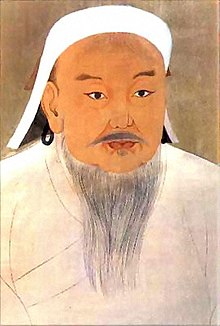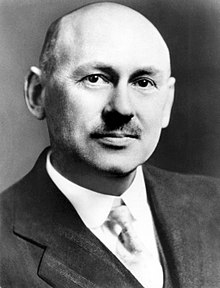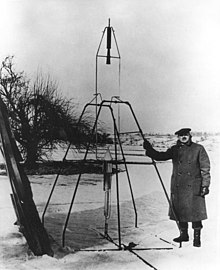The history of rocket vehicles goes back to the 13th century in China. From there developments occurred in Mongolia, India, Britain, America and Russia among many others.The availability of black powder (gunpowder) to propel projectiles was a precursor to the development of the first solid rocket. Ninth Century Chinese Taoistalchemists discovered black powder while searching for the Elixir of life; this accidental discovery led to experiments as weapons such as bombs, cannon, incendiary fire arrows and rocket-propelled fire arrows. The discovery of gunpowder was probably the product of centuries of alchemical experimentation.
Exactly when the first flights of rockets occurred is contested. The earliest verifiable notice of fireworks is a statement in 2 Vopiscus, Carus, Numerianus et Carinus, ch. xix. which says that fireworks were performed for the emperor Carinus (282-283) and later for Diocletian (284-286). A common claim is that the first recorded use of a rocket in battle was by the Chinese in 1232 against the Mongol hordes at Kai Feng Fu. This is based on an old Mandarin civil service examination question which reads "Is the defense of Kai Feng Fu against the Mongols (1232) the first recorded use of cannon?".Another question from the examinations read "Fire-arms began with the use of rockets in the dynasty of Chou (B. C. 1122-255)--in what book do we first meet with the word p'ao, now used for cannon?". The first reliable scholarly reference to rockets in China occurs in the Ko Chieh Ching Yuan (The Mirror of Research) which states that in 998 A.D. a man named Tang Fu invented a rocket of a new kind having an iron head. There were reports of fire arrows and 'iron pots' that could be heard for 5 leagues (25 km, or 15 miles) when they exploded upon impact, causing devastation for a radius of 600 meters (2,000 feet), apparently due to shrapnel. The lowering of the iron pots may have been a way for a besieged army to blow up invaders. The fire arrows were either arrows with explosives attached, or arrows propelled by gunpowder, such as the KoreanHwacha.Less controversially, one of the earliest devices recorded that used internal-combustion rocket propulsion, was the 'ground-rat,' a type of firework recorded in 1264 as having frightened the Empress-Mother Kung Sheng at a feast held in her honor by her son the Emperor Lizong.
Subsequently, one of the earliest texts to mention the use of rockets was the Huolongjing, written by the Chinese artillery officer Jiao Yu in the mid-14th century. This text also mentioned the use of the first known multistage rocket, the 'fire-dragon issuing from the water' (huo long chu shui), used mostly by the Chinese navy
 |
| Early Chinese rocket. |
Spread of rocket technology
Rocket technology first became known to Europeans following its use by the Mongols Genghis Khan and Ögedei Khan when they conquered parts of Russia, Eastern, and Central Europe. The Mongolians had acquired the Chinese technology by conquest of the northern part of China and by the subsequent employment of Chinese rocketry experts as mercenaries for the Mongol military. Reports of the Battle of Mohi in the year 1241 describe the use of rocket-like weapons by the Mongols against the Magyars. Rocket technology also spread to Korea, with the 15th century wheeled hwacha that would launch singijeonrockets. Additionally, the spread of rockets into Europe was also influenced by the Ottomans at the siege of Constantinople in 1453, although it is very likely that the Ottomans themselves were influenced by the Mongol invasions of the previous few centuries. In their history of rockets published on the Internet,NASA says "Rockets appear in Arab literature in 1258 A.D., describing Mongol invaders' use of them on February 15 to capture the city of Baghdad.
Between 1270 and 1280, Hasan al-Rammah wrote al-furusiyyah wa al-manasib al-harbiyya (The Book of Military Horsemanship and Ingenious War Devices), which included 107 gunpowder recipes, 22 of which are for rockets. According to Ahmad Y Hassan, al-Rammah's recipes were more explosive than rockets used in China at the time.
The name Rocket comes from the Italian Rocchetta (i.e. little fuse), a name of a small firecracker created by the Italian artificer Muratori in 1379.
Between 1529 and 1556 Conrad Haas wrote a book in which he described rocket technology, involving the combination of fireworks and weapons technologies. This manuscript was discovered in 1961, in the Sibiu public records (Sibiu public records Varia II 374). His work dealt with the theory of motion of multi-stage rockets, different fuel mixtures using liquid fuel, and introduced delta-shape fins and bell-shaped nozzles.Konrad Kyeser described rockets in his famous military treatise Bellifortis around 1405.
For over two centuries, the work of Polish-Lithuanian Commonwealth nobleman Kazimierz Siemienowicz "Artis Magnae Artilleriae pars prima" ("Great Art of Artillery, the First Part", also known as "The Complete Art of Artillery"), was used in Europe as a basic artillery manual. First printed in Amsterdam in 1650 it was translated to French in 1651, German in 1676, English and Dutch in 1729 and Polish in 1963. The book provided the standard designs for creating rockets, fireballs, and other pyrotechnic devices. It contained a large chapter on caliber, construction, production and properties of rockets (for both military and civil purposes), including multi-stage rockets, batteries of rockets, and rockets with delta wing stabilizers (instead of the common guiding rods).
 |
| Kyeser was infatuated with the legend of Alexander the Great: here Alexander holds a rocket, the first depiction of one |
Metal-cylinder rocket artillery
In 1792, the first iron-cased rockets were successfully developed used militarily by Hyder Ali and his son Tipu Sultan, rulers of the Kingdom of Mysore in Indiaagainst the larger British East India Company forces during the Anglo-Mysore Wars. The British then took an active interest in the technology and developed it further during the 19th century. The Mysore rockets of this period were much more advanced than what the British had seen, chiefly because of the use of iron tubes for holding the propellant; this enabled higher thrust and longer range for the missile (up to 2 km range). After Tipu's eventual defeat in the Fourth Anglo-Mysore War and the capture of the Mysore iron rockets, they were influential in British rocket development, inspiring the Congreve rocket, which was soon put into use in the Napoleonic Wars.
According to Stephen Oliver Fought and John F. Guilmartin, Jr. in Encyclopedia Britannica (2008): "Hyder Ali, prince of Mysore, developed war rockets with an important change: the use of metal cylinders to contain the combustion powder. Although the hammered soft iron he used was crude, the bursting strength of the container of black powder was much higher than the earlier paper construction. Thus a greater internal pressure was possible, with a resultant greater thrust of the propulsive jet. The rocket body was lashed with leather thongs to a long bamboo stick. Range was perhaps up to three-quarters of a mile (more than a kilometre). Although individually these rockets were not accurate, dispersion error became less important when large numbers were fired rapidly in mass attacks. They were particularly effective against cavalry and were hurled into the air, after lighting, or skimmed along the hard dry ground. Hyder Ali's son, Tipu Sultan, continued to develop and expand the use of rocket weapons, reportedly increasing the number of rocket troops from 1,200 to a corps of 5,000. In battles at Seringapatam in 1792 and 1799 these rockets were used with considerable effect against the British."
Accuracy of early rockets
William Congreve, son of the Comptroller of the Royal Arsenal, Woolwich, London, became a major figure in the field. From 1801, Congreve researched on the original design of Mysore rockets and set on a vigorous development program at the Arsenal's laboratory. Congreve prepared a new propellant mixture, and developed a rocket motor with a strong iron tube with conical nose. This early Congreve rocket weighed about 32 pounds (14.5 kilograms). The Royal Arsenal's first demonstration of solid fuel rockets was in 1805. The rockets were effectively used during the Napoleonic Wars and the War of 1812. Congreve published three books on rocketry.
From there, the use of military rockets spread throughout Europe. At the Battle of Baltimore in 1814, the rockets fired on Fort McHenry by the rocket vesselHMS Erebus were the source of the rockets' red glare described by Francis Scott Key in The Star-Spangled Banner. Rockets were also used in the Battle of Waterloo.
Early rockets were very inaccurate. Without the use of spinning or any gimballing of the thrust, they had a strong tendency to veer sharply off course. The early British Congreve rockets reduced this somewhat by attaching a long stick to the end of a rocket (similar to modern bottle rockets) to make it harder for the rocket to change course. The largest of the Congreve rockets was the 32-pound (14.5 kg) Carcass, which had a 15-foot (4.6 m) stick. Originally, sticks were mounted on the side, but this was later changed to mounting in the center of the rocket, reducing drag and enabling the rocket to be more accurately fired from a segment of pipe.
The accuracy problem was greatly improved in 1844 when William Hale modified the rocket design so that thrust was slightly vectored, causing the rocket to spin along its axis of travel like a bullet. The Hale rocket removed the need for a rocket stick, travelled further due to reduced air resistance, and was far more accurate.
Theories of interplanetary rocketry
At the beginning of the 20th Century, there was a burst of scientific investigation into interplanetary travel, largely driven by the inspiration of fiction by writers such as Jules Verne and H.G.Wells. Scientists seized on the rocket as a technology that was able to achieve this in real life.
In 1903, high school mathematics teacher Konstantin Tsiolkovsky (1857–1935), published Исследование мировых пространств реактивными приборами (The Exploration of Cosmic Space by Means of Reaction Devices), the first serious scientific work on space travel. The Tsiolkovsky rocket equation—the principle that governs rocket propulsion—is named in his honor (although it had been discovered previously). He also advocated the use of liquid hydrogen and oxygen for propellant, calculating their maximum exhaust velocity. His work was essentially unknown outside the Soviet Union, but inside the country it inspired further research, experimentation and the formation of the Society for Studies of Interplanetary Travel in 1924.
In 1912, Robert Esnault-Pelterie published a lecture on rocket theory and interplanetary travel. He independently derived Tsiolkovsky's rocket equation, did basic calculations about the energy required to make round trips to the Moon and planets, and he proposed the use of atomic power (i.e. Radium) to power a jet drive.
In 1912 Robert Goddard, inspired from an early age by H.G.Wells, began a serious analysis of rockets, concluding that conventional solid-fuel rockets needed to be improved in three ways. First, fuel should be burned in a small combustion chamber, instead of building the entire propellant container to withstand the high pressures. Second, rockets could be arranged in stages. Finally, the exhaust speed (and thus the efficiency) could be greatly increased to beyond the speed of sound by using a De Laval nozzle. He patented these concepts in 1914. He, also, independently developed the mathematics of rocket flight.
In 1920, Goddard published these ideas and experimental results in A Method of Reaching Extreme Altitudes.[30]The work included remarks about sending a solid-fuel rocket to the Moon, which attracted worldwide attention and was both praised and ridiculed. A New York Times editorial suggested:
| “ | That Professor Goddard, with his 'chair' in Clark College and the countenancing of the Smithsonian Institution, does not know the relation of action to reaction, and of the need to have something better than a vacuum against which to react -- to say that would be absurd. Of course he only seems to lack the knowledge ladled out daily in high schools. | ” |
—New York Times, 13 January 1920 | ||
In 1923, Hermann Oberth (1894–1989) published Die Rakete zu den Planetenräumen ("The Rocket into Planetary Space"), a version of his doctoral thesis, after the University of Munich rejected it.
In 1924, Tsiolkovsky also wrote about multi-stage rockets, in 'Cosmic Rocket Trains'
Modern rocketry
Pre-World War II
Modern rockets were born when Goddard attached a supersonic (de Laval) nozzle to a liquid-fueled rocket engine's combustion chamber. These nozzles turn the hot gas from the combustion chamber into a cooler, hypersonic, highly directed jet of gas, more than doubling the thrust and raising the engine efficiency from 2% to 64%. In 1926, Robert Goddard launched the world's first liquid-fueled rocket in Auburn, Massachusetts.
During the 1920s, a number of rocket research organizations appeared worldwide. In the mid-1920s,German scientists had begun experimenting with rockets which used liquid propellants capable of reaching relatively high altitudes and distances. 1927 the German car manufacturer Opel began to research rocket vehicles together with Mark Valier and the solid-fuel rocket builder Friedrich Wilhelm Sander. In 1928, Fritz von Opel drove with a rocket car, the Opel-RAK.1 on the Opel raceway in Rüsselsheim, Germany. In 1929 von Opel started at the Frankfurt-Rebstock airport with the Opel-Sander RAK 1-airplane. This was maybe the first flight with a manned rocket-aircraft. In 1927 and also in Germany, a team of amateur rocket engineers had formed the Verein für Raumschiffahrt(German Rocket Society, or VfR), and in 1931 launched a liquid propellant rocket (using oxygen andgasoline).
From 1931 to 1937 in Russia, extensive scientific work on rocket engine design occurred inLeningrad at the Gas Dynamics Laboratory there. Well-funded and staffed, over 100 experimental engines were built under the direction of Valentin Glushko. The work included regenerative cooling,hypergolic propellant ignition, and fuel injector designs that included swirling and bi-propellant mixing injectors. However, the work was curtailed by Glushko's arrest during Stalinist purges in 1938. Similar work was also done by the Austrian professor Eugen Sänger who worked on rocket powered spaceplanes such as Silbervogel (sometimes called the 'antipodal' bomber.)
On November 12, 1932 at a farm in Stockton NJ, the American Interplanetary Society's attempt to static fire their first rocket (based on German Rocket Society designs) failed in a fire.
In 1930s, the Reichswehr (which in 1935 became the Wehrmacht) began to take an interest in rocketry.Artillery restrictions imposed by theTreaty of Versailles limited Germany's access to long distance weaponry. Seeing the possibility of using rockets as long-range artillery fire, the Wehrmacht initially funded the VfR team, but because their focus was strictly scientific, created its own research team. At the behest of military leaders, Wernher von Braun, at the time a young aspiring rocket scientist, joined the military (followed by two former VfR members) and developed long-range weapons for use in World War II by Nazi Germany.







No comments:
Post a Comment